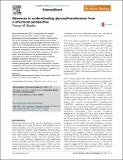Files in this item
Advances in understanding glycosyltransferases from a structural perspective
Item metadata
| dc.contributor.author | Gloster, Tracey M | |
| dc.date.accessioned | 2014-10-10T11:31:03Z | |
| dc.date.available | 2014-10-10T11:31:03Z | |
| dc.date.issued | 2014-10 | |
| dc.identifier | 155018162 | |
| dc.identifier | 671d40fb-9541-4b68-91a0-5254d981e90f | |
| dc.identifier | 25240227 | |
| dc.identifier | 84908673948 | |
| dc.identifier | 000345203000018 | |
| dc.identifier.citation | Gloster , T M 2014 , ' Advances in understanding glycosyltransferases from a structural perspective ' , Current Opinion in Structural Biology , vol. 28 , pp. 131-141 . https://doi.org/10.1016/j.sbi.2014.08.012 | en |
| dc.identifier.issn | 0959-440X | |
| dc.identifier.uri | https://hdl.handle.net/10023/5535 | |
| dc.description.abstract | Glycosyltransferases (GTs), the enzymes that catalyse glycosidic bond formation, create a diverse range of saccharides and glycoconjugates in nature. Understanding GTs at the molecular level, through structural and kinetic studies, is important for gaining insights into their function. In addition, this understanding can help identify those enzymes which are involved in diseases, or that could be engineered to synthesize biologically or medically relevant molecules. This review describes how structural data, obtained in the last 3-4 years, have contributed to our understanding of the mechanisms of action and specificity of GTs. Particular highlights include the structure of a bacterial oligosaccharyltransferase, which provides insights into N-linked glycosylation, the structure of the human O-GlcNAc transferase, and the structure of a bacterial integral membrane protein complex that catalyses the synthesis of cellulose, the most abundant organic molecule in the biosphere. | |
| dc.format.extent | 11 | |
| dc.format.extent | 2540075 | |
| dc.language.iso | eng | |
| dc.relation.ispartof | Current Opinion in Structural Biology | en |
| dc.subject | QH301 Biology | en |
| dc.subject | SDG 3 - Good Health and Well-being | en |
| dc.subject.lcc | QH301 | en |
| dc.title | Advances in understanding glycosyltransferases from a structural perspective | en |
| dc.type | Journal article | en |
| dc.contributor.sponsor | The Wellcome Trust | en |
| dc.contributor.institution | University of St Andrews. School of Biology | en |
| dc.contributor.institution | University of St Andrews. Biomedical Sciences Research Complex | en |
| dc.identifier.doi | https://doi.org/10.1016/j.sbi.2014.08.012 | |
| dc.description.status | Peer reviewed | en |
| dc.identifier.grantnumber | 095828/Z/11/Z | en |
This item appears in the following Collection(s)
Items in the St Andrews Research Repository are protected by copyright, with all rights reserved, unless otherwise indicated.

